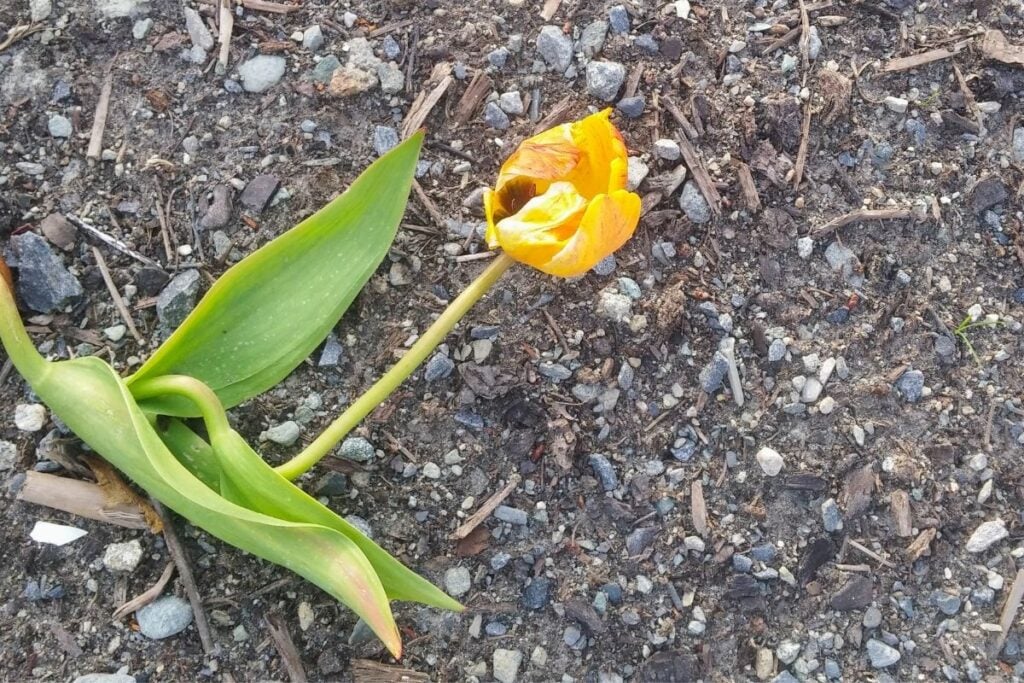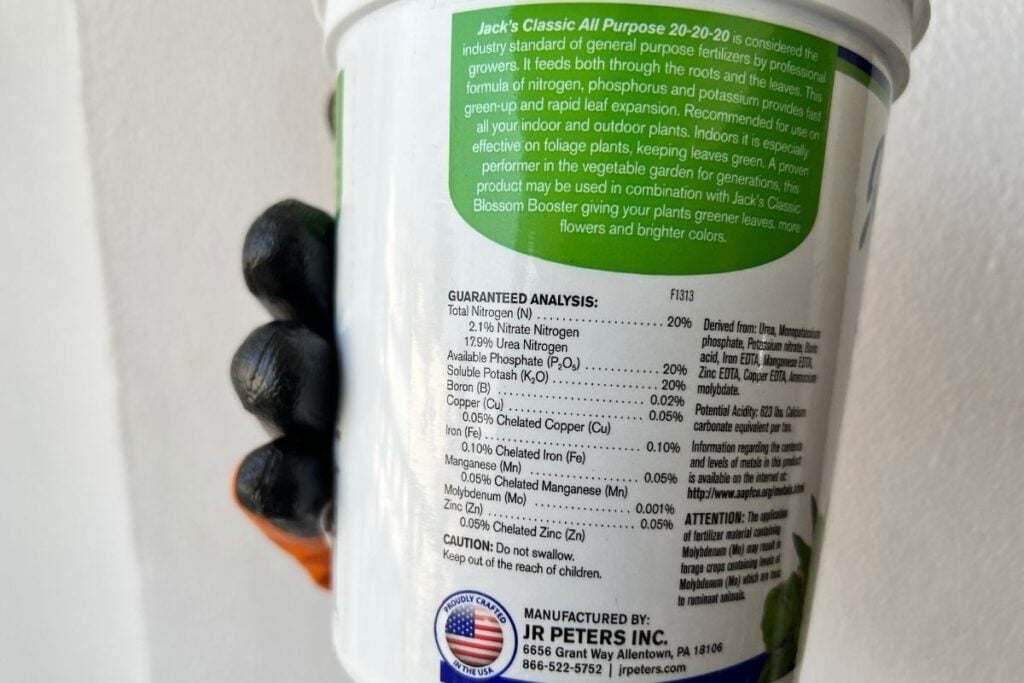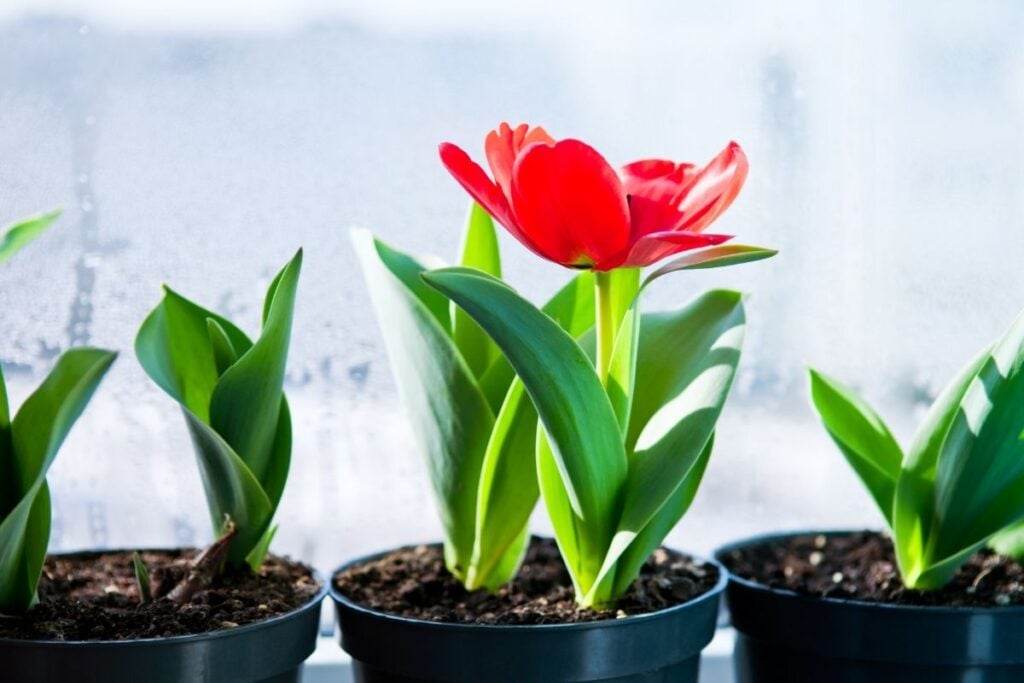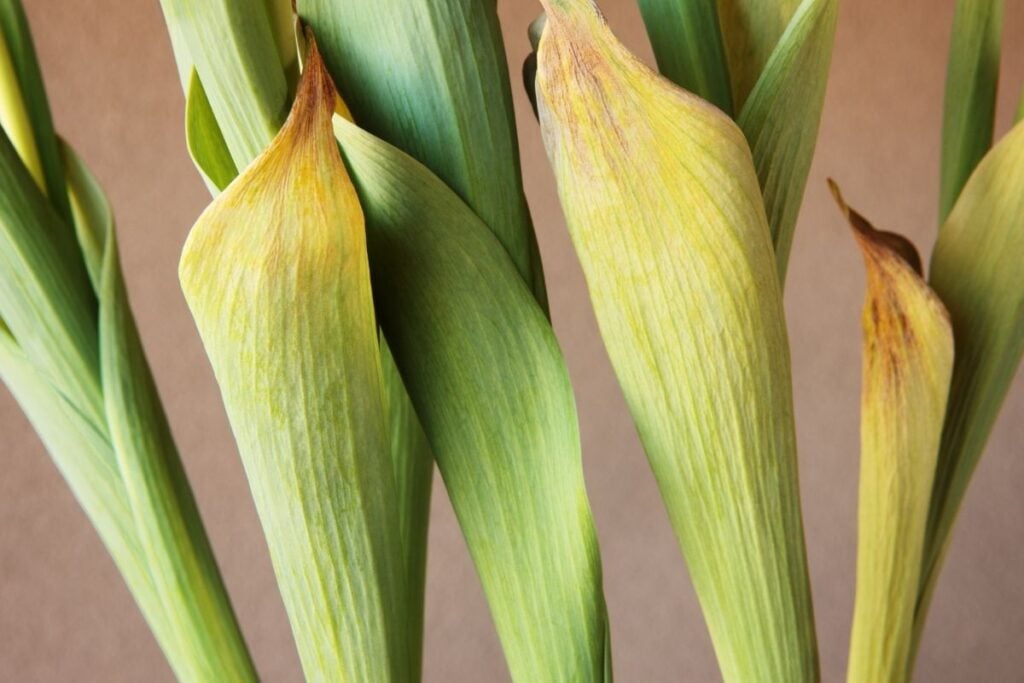Tulips are prevalent outdoor perennial flowers. They are low-maintenance plants and can be grown quickly. Tulips require an adequate amount of water and proper sunlight to keep them healthy. Apart from that fertilizing your tulips with the correct type of fertilizer is also equally important for the plant.
So, in this article, we shall learn what is the best fertilizer for tulips and how often should we use the same.
Generally, Tulips need a well-balanced fertilizer with an NPK ratio of 10:10:10 or 20:20:20 for ideal growth. Tulips don’t need a lot of nutrients, so dosing them once or twice a year is enough. You can also use a slow-release fertilizer to provide a constant nutrient supply to the plant.
You will see healthy and beautiful blooms on your tulips during their blooming season if you can get the fertilizing right. So read this article to get the information about fertilizing your tulips.

Do tulips need fertilizer?
Tulips don’t require fertilizers frequently. Although these plants don’t need too much fertilizer, you must feed the tulips to boost their growth and bloom.
While planting tulips, you should go for a slow-release fertilizer for their healthy growth. It is vital to fertilize your tulips because the soil mix does not contain all the necessary nutrients required for proper growth.
Soil mix mostly loses its nutrients due to watering. When you water the soil, the nutrients present in it flush out. Eventually, the plant becomes weak if you don’t add fertilizer which is nothing but nutrients.
Properly fertilizing your tulips will help the plants grow faster and bloom more. You should always provide your plants with sufficient and correct fertilizer.
Also read: What Kind Of Soil Is Good For Tulips? (Best Soil Mix)
Signs of lack of fertilizers

You will get to see various problems in tulips if they are not getting enough nutrients they require.
The signs are:
- Stunted growth
- Lack of blooms
- Leggy growth
- Discoloration in leaves
- Weak stems
- Poor root growth
If you notice any of the problems in your tulips, provide proper nutrients to fix these.
What essential nutrients do tulips need?

Before fertilizing your tulips, you first need to know which nutrients your tulips will need.
Like other plants, tulips require essential nutrients such as nitrogen, phosphorous, potassium, and secondary nutrients such as calcium and magnesium. Now let’s find out why your tulips need all these nutrients.
Nitrogen: Nitrogen is necessary for regulating the metabolic processes in tulips and keeping the foliage healthy. It also helps the plant proliferate and increases its blooming rate.
You should always provide nitrogen in proper quantity to encourage blooms in tulips. But using too much of it can decrease the growth and cause discoloration in the leaves.
Phosphorous: Phosphorous regulates the photosynthesis process by helping form oil, sugar, starch, etc., in plants.
It also helps in rapid growth, encourages blooming and root growth. If there is a lack of phosphorous in tulips, it can stunt the growth of roots and shoots.
On the other hand, too much phosphorous can damage tulips, so be careful while providing phosphorous. Phosphorous can come as a fertilizer, bone meal, and superphosphate.
Potassium: Potassium helps build protein tulips, and it prevents various kinds of diseases. If your tulips lack potassium, you will get to see brown leaves on tips and stunted growth. This nutrient often comes from organic matter and fertilizers.
Calcium: Calcium helps form cell walls and membranes and ensures rapid growth in plants. It also helps the roots grow faster and become stronger.
Lack of calcium in tulips can often cause yellow and brown leaves and make the soil more acidic, damaging or burning the roots.
Magnesium: Magnesium is essential for tulips for the process of photosynthesis. Without magnesium, chlorophyll will not absorb energy from the sun, needed to synthesize the food.
It also helps in activating many plant enzymes needed for the growth of a plant. Lack of magnesium can cause poor and stunted growth in tulips.
Looking for gardening supplies? We have tested 100's of products before recommending them to you guys. Check out our best pick below:
| Image | Gardening Supplies | Best Price? |
|---|---|---|
 Top
Top Top
Top | Raised Garden Bed Kit | Check On Amazon |
 | XLUX Soil Moisture Meter, Plant Water Monitor, Soil Hygrometer Sensor for Gardening, Farming, Indoor and Outdoor Plants, No Batteries Required | No Results |
 Top
Top Top
Top | 82 Pcs Garden Tools Set and Extra Succulent Tools Set | Check On Amazon |
 | Joeys Garden Expandable Garden Hose with 8 Function Hose Nozzle, Lightweight Anti-Kink Flexible Garden Hoses, Extra Strength Fabric with Double Latex Core, (50 FT, Black) | No Results |
 Top
Top Top
Top | Dual Chamber Compost Tumbler | Check On Amazon |
 Top
Top Top
Top | Sunnyglade Plant Stakes | Check On Amazon |
 Top
Top Top
Top | Organic Cold Pressed Neem Seed Oil | Check On Amazon |
 Top
Top Top
Top | Mighty Mint Gallon :-Insect and Pest Control Peppermint Oil | Check On Amazon |
 Top
Top Top
Top | Scotts DiseaseEx Lawn Fungicide | Check On Amazon |
 Top
Top Top
Top | Jacks Classic 20-20-20 All Purpose Fertilizer | Check On Amazon |
 Top
Top Top
Top | 30,000 Seeds Pollinator Attracting Wildflower Mixture | Check On Amazon |
 Top
Top Top
Top | Survival Vegetable Seeds Garden Kit-Over 16,000 Seeds | Check On Amazon |
What is the best fertilizer for tulips?
While choosing a fertilizer for tulips, consider the NPK ratio that your plants require. NPK stands for Nitrogen, Phosphorous, and Potassium, which all your plants need, including the tulips.
The correct ratio is essential for the health and growth of your Tulips. You should always use a well-balanced fertilizer in the NPK ratio of 10:10:10.
Make sure to use a slow-release fertilizer. As tulips don’t need fertilizers frequently, this slow-release fertilizer releases nutrients to the roots from time to time.
Types of fertilizers

Primarily you will find two types of fertilizers: organic and inorganic. Let us discuss both, and then you can choose whichever you think would be best for your tulips.
Inorganic fertilizers
Inorganic fertilizers are made up of chemicals and are manufactured artificially in exact doses. There are three types of inorganic fertilizers: granular, slow-release, and liquid fertilizer.
The only inorganic fertilizer you should use on your tulips is the slow-release fertilizer. Granular and liquid fertilizers can burn the plants because of their high chemical content.
Always apply a well-balanced 10:10:10 or 20:20:20 fertilizer. Apply it on the topsoil and not inside the soil to prevent root burn.
Slow-release fertilizers break down the nutrients in small amounts and release that to the soil over time, thus reducing the risk of burn and preventing overfertilization.
Organic fertilizers
Organic fertilizers are made up of natural ingredients such as compost, blood meal, bone meal, greensand, etc.
Here the main question arises whether you can use blood meal, bone meal, and grand sand without burning your tulips? Let us find out.
Bone meal
Bone meal is an organic fertilizer that provides nutrients such as phosphorous, nitrogen, and calcium. Bone meal fertilizer is mainly used for providing phosphorous to your plants.
Adding phosphorous to tulips doesn’t cause any harm. But many soil types already contain phosphorous, so it is not always necessary to add bone meal to plants.
Make sure you don’t add bone meal to tulips while planting them. It is required only when the soil has a deficiency in phosphorous.
If you want to nourish your tulips with nutrients, you should apply some compost instead of adding bone meal. Compost is more convenient than a bone meal.
However, if your tulips show a deficiency in phosphorous, you can add bone meal. The best time to add a bone meal is after the tulips have bloomed. These plants lack phosphorous during this time, and that is when they need fertilizers the most.
If you want to add bone meal, don’t apply it directly to the soil. Always scratch the soil before adding it to break it down faster and mix it with the soil thoroughly.
Blood meal
A blood meal contains highly rich protein substances.
A blood meal is mainly added to provide protein and nitrogen to your plants. If you want to increase the nitrogen levels in tulips, you can add this blood meal.
If you want to add blood meal to your tulips, take a garden fork and scratch the soil with it and apply it if the substance is powdery.
You can also mix blood meal with water and pour the substance into the soil. Make sure you don’t apply blood meals frequently. If used in higher concentrations, it can burn the roots of tulips, so apply this fertilizer only when they need it.
Greensand
Greensand is one of the best organic fertilizers you can use for tulips. This fertilizer gently releases minerals, loosens the soil, and increases root growth.
It also protects the plants from root burn, which happens due to strong chemicals. It contains iron, potassium, and magnesium in high amounts. If your tulips need these nutrients, you can add green sand fertilizer without giving it a second thought.
Apply greensand to tulips by scratching the soil. Add it in a small amount to avoid overfertilization.
Best fertilizer for tulips
There is a variety of fertilizers available in the market. However, after extensive research and trying out many of them, I have chosen some of the best ones for you.
If you are looking for the best fertilizer for tulips, you can pick any one of these:
- Jacks Classic 20-20-20 All Purpose Fertilizer
- Triple 10 All Purpose Liquid Fertilizer
- Worm Castings Organic Fertilizer
- Espoma BM10 Organic Traditions Bone Meal
- Espoma Blood Meal Granules Organic Plant Food
When to fertilize tulips?

Tulips need fertilization once a year. The ideal time for fertilizing your tulips is in the fall. During fall, tulips start growing new roots to prepare themselves for the winter.
Fall or autumn is the ideal time to fertilize the tulips as they take up the nutrients in the best possible manner. Avoid fertilizing your tulips in spring, as the roots will begin to die just after the spring season.
When spring ends, summer begins, which is the dormant period for tulips. During this time, the roots won’t be able to absorb the nutrients from the fertilizers.
How to fertilize tulips while planting them?
The process of fertilizing tulips is not complicated. You just need a correct ratio of fertilizer and a proper method.
- Choose the correct dose of slow-release fertilizer for tulips.
- Dig up the top 10-12 inches of soil by using a spade or hoe.
- Spread 1 inch of compost over the soil surface.
- Then, take at least ½ pound of 10:10:10 fertilizer and apply it in 50 square feet of bed.
- Amend the soil with both compost and fertilizer in a proper manner. Ensure that the soil is loose enough so that the roots will be able to function correctly.
- After that, plant tulips 6 inches dip into the soil and cover it with a prepared soil mix.
- Water it thoroughly to remove the air bubbles in the roots.
- Repeat the process in the fall when all the bloom has already died.
What happens if you overfertilize tulips?

As tulips don’t need a lot of fertilizer, too much of it can even kill these plants. Excessive fertilization can burn the roots of tulips and cause weakness to the plants.
You should use a perfectly balanced fertilizer for the healthy growth of tulips. If you have overfertilized your tulips by any chance, you will notice various symptoms.
- Brown tips on leaves
- Burnt and black roots
- Wilting of lower leaves
- Stunted growth
- Black spots on leaves
If you notice issues on your tulips, try to solve this problem immediately to avoid further damage.
How to fix overfertilized tulips?
If you have overfertilized your tulips, you can fix them by following these steps:
- Remove the already damaged leaves and stems.
- Flush the soil to remove the excess fertilizers from the soil surface.
- Water your plants and soak the soil thoroughly until it drains out from the pot or container.
- Repeat this process for 30 minutes to remove the excess fertilizer.
- Water it again when the soil gets dry after some time.
- You can also remove the top inches of fertilizer by scratching the soil.
- If you want to make a fresh start, you can repot the entire plant into a new container by removing the damaged roots and adding a fresh organic soil mix.
Tips for fertilizing your tulips
- While fertilizing your tulips, don’t apply fertilizers inside the soil as they can cause severe damage to the roots. Instead, apply it on the top of the soil by scratching it with a spade or hoe.
- If you are using organic fertilizer, it can attract various kinds of pests. Check frequently to find out if any pests have attacked your tulips. If yes, immediately remove them.
- If you follow the proper fertilizing steps and do it correctly, you will have healthy tulips with vibrant blooms.
Source: Wikipedia, North Dakota Stae University, The Royal Horticultural Society.
